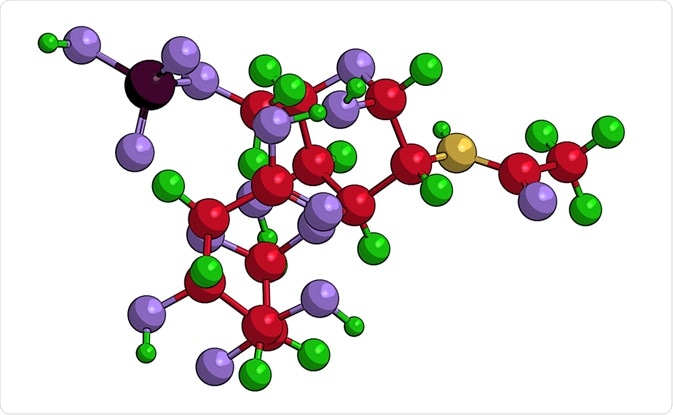There are a multitude of chemical compounds that play a variety of functions in organisms including proteins, lipids, and carbohydrates. Glycans, which until recently have been poorly understood, are another class of compounds that have several important functions within organisms. This article will discuss more about these organic compounds.

Image Credit: Raimundo79/Shutterstock.com
Glycans – An Overview
Glycans are formed of several monosaccharides linked by chemical bonds. These long, chain-like structures with a variety of forms, from long, straight chains to incredibly complex branched ones. The term can also be applied to the carbohydrate portion of organic molecules.
In organisms, glycans are found attached to other molecules such as proteins and lipids and play several important biological roles. Examples of functionally important glycans include cellulose and chitin. The two classes of glycans, N-linked and O-linked, are common in eukaryotic cells, but some prokaryotic cells contain them.
N- and O-linked glycans are assembled in different locations and manners within the cell. N-linked glycans are assembled on the endoplasmic reticulum, and O-linked glycans are assembled in the Golgi apparatus.
Function
Sugars are important organic molecules for metabolism and energy generation, and, indeed, Glycans have well-understood roles in these vital biological functions. Beyond this, glycans are important structural molecules that play a multitude of cellular roles. Many infectious and symbiotic organisms also recognize and specifically bind to glycans present on external cell surfaces, which mediates their interactions with the host.
N-linked glycans are extremely important for protein folding in eukaryotic cells. This is achieved due to the specific binding of chaperone proteins to glucose residues on the glycan. After folding, these residues are removed, and the glycan then undergoes further processing. The glucose residues are reattached if folding proves to be incomplete. The process is repeated until proper folding is achieved, or the process fails, and the protein is excreted from the endoplasmic reticulum and degraded.
N-linked glycans also play a crucial role in cell-cell interactions. Furthermore, they are intimately involved with the targeting of lysosomal enzymes.
O-linked glycans play important roles as well. Sialyl Lewis x (SLex) is important for immune responses. Mucin (a protein present in saliva) has been shown to be important for the healthy development of gut microflora. Some strains of intestinal bacteria bind to mucin, aiding their proliferation throughout the gut. Notch, a transmembrane receptor that plays a role in the development and cell fate decisions, is an O-linked glycan.
Glycans also play a role in the development and mediation of several diseases. Changes in glycosylation are often hallmarks of different disease states.
The Role of Glycans in Cancer and Chronic Inflammation.
Glycans undergo structural changes (such as over-and under-expression) in diseases such as chronic inflammation and cancer. Glycans usually restricted to embryonic tissue can also undergo neo expression. This is usually due to changes in expression levels of glycosylating enzymes in cancerous cells compared to healthy ones. Cancerous cells display glycans with different structures to those present in normal, healthy cells.
This phenomenon was first observed in the 1970s but was initially poorly understood. Recent advancements over the last couple of decades in proteomics, genomics, and mass spectrometry have meant that specific glycan structures have been associated with various disease states.
Given the functional link between aberrant glycosylation and malignancy, novel therapeutics that target disease-state glycans may be effective in treating cancer.
There is also evidence that glycans play a role in chronic inflammation. 6-sulpho sialyl Lewis x is one such glycan. It initiates the homing of leukocytes to sites of chronic inflammation. It helps to enable leukocyte-endothelial cell adhesion. Several carbohydrate epitopes are expressed at disease sites.
Cellular Glycans and Alzheimer’s Disease.
Alzheimer’s disease (AD) is a degenerative disease that is the most common type of dementia. Recent research has shown that two key molecules, amyloid-beta and tau are critical for the development of Alzheimer’s disease. However, there is still no effective therapy for this disease.
Cellular glycans are known to play a crucial role in AD pathogenesis. This makes them interesting targets for biomarkers or novel therapeutics for the disease. An example is a decrease in O-GlcNAc on tau. An approach to drug development using glycobiology could prove beneficial for the treatment of this major cause of dementia in the future.
In Conclusion
Glycans play several important roles in organisms, both metabolically and structurally. Understanding their structure in both healthy and diseased systems may lead to a new class of therapeutics for many diseases and improve nutrition by manipulating their interactions within the gut microbiota. As we understand more about these interesting organic molecules the potential for therapies based upon them is vast.
References: